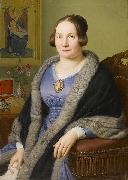Franz Ittenbach Oil Painting ReproductionAll Franz Ittenbach Oil Paintings(April 18, 1813 - December 1, 1879) was a German religious painter from Königswinter, North Rhine-Westphalia, at the foot of the Drachenfels. Ittenbach began his art education as a student of Kaufmann, then left to study under Franz Katz in Cologne. In 1832, Ittenbach became a pupil, at the age of 19, of the Desseldorf Academy, where he also received private lessons from its president, Schadow. He was a member of the Nazarene movement and associated himself mainly with three of his friends and fellow-students: Karl and Andreas Meller, and Ernst Deger. The four men travelled about in Germany, studying and painting together. From 1839 to 1842, Ittenbach lived in Italy. On his return, he stayed in Munich for some time. In 1849, he returned to Desseldorf. From 1859 until his death, he was a member of the artist club "Malkasten". Ittenbach was exceedingly religious and persistently declined any commissions for mythological or pagan subjects. As a rule, he devoted his energies exclusively to church decoration. He would precede the execution of his greatest works with devout religious exercises, including confession and communion. His finest paintings are said to be found at Bonn, in the church of St. Remigius, and in Breslau in a church dedicated to the same saint. There is also a remarkable "Holy Family" dated 1861, painted for Prince Liechtenstein in his private chapel near Vienna. Most of his other works can be found in various Catholic churches in Germany. His only important fresco was painted in 1844 in a church at Remagen. Ittenbach was a popular painter in court circles, a member of most of the European academies, and the recipient of many medals and decorations. He painted a few portraits, but they were unimportant; his main work was his altar-pieces. |
|||

|
|||
|
|
|||
|
||||||||
| Franz Ittenbach (April 18, 1813 - December 1, 1879) was a German religious painter from Königswinter, North Rhine-Westphalia, at the foot of the Drachenfels. Ittenbach began his art education as a student of Kaufmann, then left to study under Franz Katz in Cologne. In 1832, Ittenbach became a pupil, at the age of 19, of the Desseldorf Academy, where he also received private lessons from its president, Schadow. He was a member of the Nazarene movement and associated himself mainly with three of his friends and fellow-students: Karl and Andreas Meller, and Ernst Deger. The four men travelled about in Germany, studying and painting together. From 1839 to 1842, Ittenbach lived in Italy. On his return, he stayed in Munich for some time. In 1849, he returned to Desseldorf. From 1859 until his death, he was a member of the artist club "Malkasten". Ittenbach was exceedingly religious and persistently declined any commissions for mythological or pagan subjects. As a rule, he devoted his energies exclusively to church decoration. He would precede the execution of his greatest works with devout religious exercises, including confession and communion. His finest paintings are said to be found at Bonn, in the church of St. Remigius, and in Breslau in a church dedicated to the same saint. There is also a remarkable "Holy Family" dated 1861, painted for Prince Liechtenstein in his private chapel near Vienna. Most of his other works can be found in various Catholic churches in Germany. His only important fresco was painted in 1844 in a church at Remagen. Ittenbach was a popular painter in court circles, a member of most of the European academies, and the recipient of many medals and decorations. He painted a few portraits, but they were unimportant; his main work was his altar-pieces. |
||||||||
|
|
||||||||
| Gemälde IDENTIFIZIERUNG:: 94006 Portrait of Margarete von Soist. Signed and dated Oil on canvas, ca. 90 x 66 cm Date 1849(1849) cjr |
||||||||
|
|
||||||||
|
| VORHERIGER KÜNSTLER NÄCHSTER KÜNSTLER | |||||||
|
|
||||||||
|
Franz Ittenbach (April 18, 1813 - December 1, 1879) was a German religious painter from Königswinter, North Rhine-Westphalia, at the foot of the Drachenfels. Ittenbach began his art education as a student of Kaufmann, then left to study under Franz Katz in Cologne. In 1832, Ittenbach became a pupil, at the age of 19, of the Desseldorf Academy, where he also received private lessons from its president, Schadow. He was a member of the Nazarene movement and associated himself mainly with three of his friends and fellow-students: Karl and Andreas Meller, and Ernst Deger. The four men travelled about in Germany, studying and painting together. From 1839 to 1842, Ittenbach lived in Italy. On his return, he stayed in Munich for some time. In 1849, he returned to Desseldorf. From 1859 until his death, he was a member of the artist club "Malkasten". Ittenbach was exceedingly religious and persistently declined any commissions for mythological or pagan subjects. As a rule, he devoted his energies exclusively to church decoration. He would precede the execution of his greatest works with devout religious exercises, including confession and communion. His finest paintings are said to be found at Bonn, in the church of St. Remigius, and in Breslau in a church dedicated to the same saint. There is also a remarkable "Holy Family" dated 1861, painted for Prince Liechtenstein in his private chapel near Vienna. Most of his other works can be found in various Catholic churches in Germany. His only important fresco was painted in 1844 in a church at Remagen. Ittenbach was a popular painter in court circles, a member of most of the European academies, and the recipient of many medals and decorations. He painted a few portraits, but they were unimportant; his main work was his altar-pieces. |
||||||||
|
|
||||||||
|
KONTAKTIEREN Sie UNS |






